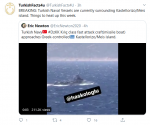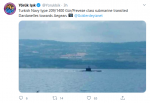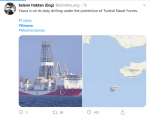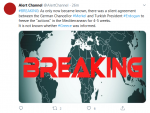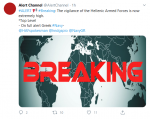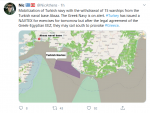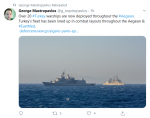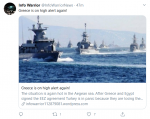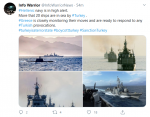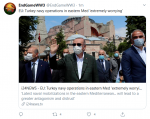You are using an out of date browser. It may not display this or other websites correctly.
You should upgrade or use an alternative browser.
You should upgrade or use an alternative browser.
WAR Regional conflict brewing in the Mediterranean
- Thread starter danielboon
- Start date
-
- Tags
- middle east
jward
passin' thru
 New Intel Indicates Russia May Have Sent S-300 Or S-400 Surface To Air Missiles To Libya
New Intel Indicates Russia May Have Sent S-300 Or S-400 Surface To Air Missiles To LibyaInitial photos from Ras Lanuf and recent transport flights suggest Moscow may have bolstered Haftar's defenses by providing advanced SAM batteries.
By Thomas NewdickAugust 6, 2020
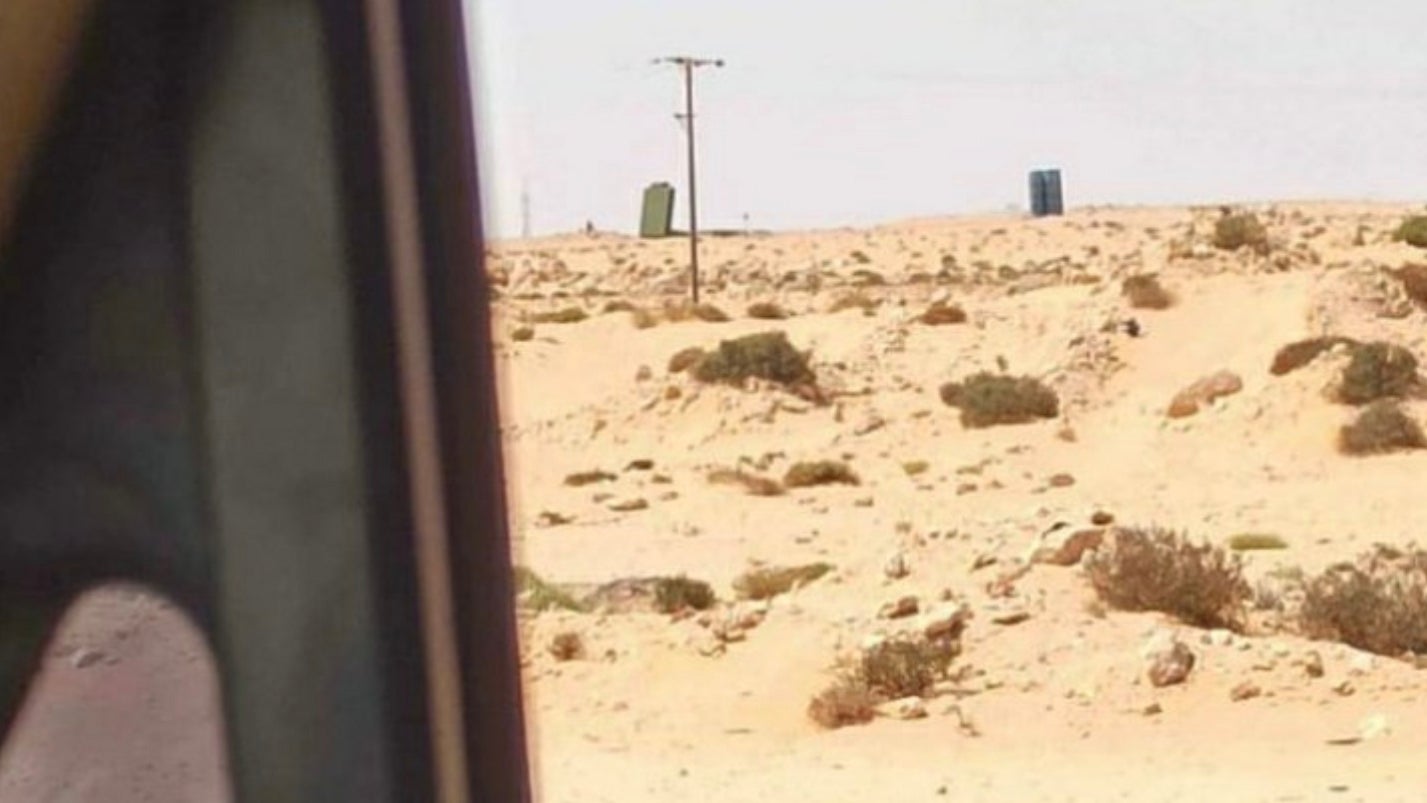
SHARE
Imagery appearing on social media channels seems to show the deployment of a Russian-made surface-to-air missile system — from either the S-300 or S-400 family — deployed near Ras Lanuf on the Libyan coast. The oil port is controlled by the Libyan National Army (LNA) commanded by Field Marshal Khalifa Haftar. Should the presence of these weapons be confirmed, it would mark a new significant escalation in Libya’s civil war and in the involvement of foreign powers backing either side in the conflict.
Unconfirmed media reports last month suggested the LNA had deployed the S-300 along the eastern border with Egypt. The veracity of these reports is unclear as Ras Lanuf is nowhere near the border with Egypt.
Two Su-24 Combat Jets Seen In Satellite Image Of Libyan Air Base As Air War IntensifiesBy Joseph Trevithick Posted in The War Zone
Russian MiG-29 And Su-24 Combat Jets Caught In-Flight At Libyan Base In New Satellite ImagesBy Joseph Trevithick Posted in The War Zone
Russia Now Has At Least 14 Combat Jets In Libya As Satellite Images Reveal New DetailsBy Joseph Trevithick Posted in The War Zone
Mysterious MiG-29 Fighter Appears At Libyan Air Base Held By Russian-Backed ForcesBy Joseph Trevithick Posted in The War Zone
MiG-29 Fighters Were At Russia's Air Base In Syria Just Before Showing Up In Libya (Updated)By Tyler Rogoway Posted in The War Zone
However, the reported appearance of the air defense system in Libya does follow a flight by a Russian Aerospace Forces An-124 strategic airlifter into Libya’s Al Khadim Air Base on Aug. 3. The transport flew in from Mozdok Air Base in Russia’s Caucasus region, making what is thought to be the type’s first appearance in Libya since Moscow’s stepped up its involvement in the ongoing civil war in support of Haftar’s LNA forces. Before its stopover at Mozdok, the An-124 had departed from Vnukovo in Moscow.#Russian made hardware in Ras Lanuf identified as 96L6/96L6E "Cheese Board" early-warning and acquisition radar and, possibly, and S-300 missile launcher.#LNA #Libyahttps://t.co/1d0Ci0MDex
— Yellow (@Yellow34950210) August 5, 2020
The An-124 is typically used to transport bulky equipment, which could include S-300 and S-400 systems and their supporting elements. Il-76 transports — operated both by the Russian military and by contractors — that have been making regular runs to Libya aren’t big enough to handle the larger components of either of the S-300 or S-400. It’s notable that when Turkey received its initial S-400s, Russia delivered components in both An-124s and Il-76s, as The War Zone described here.
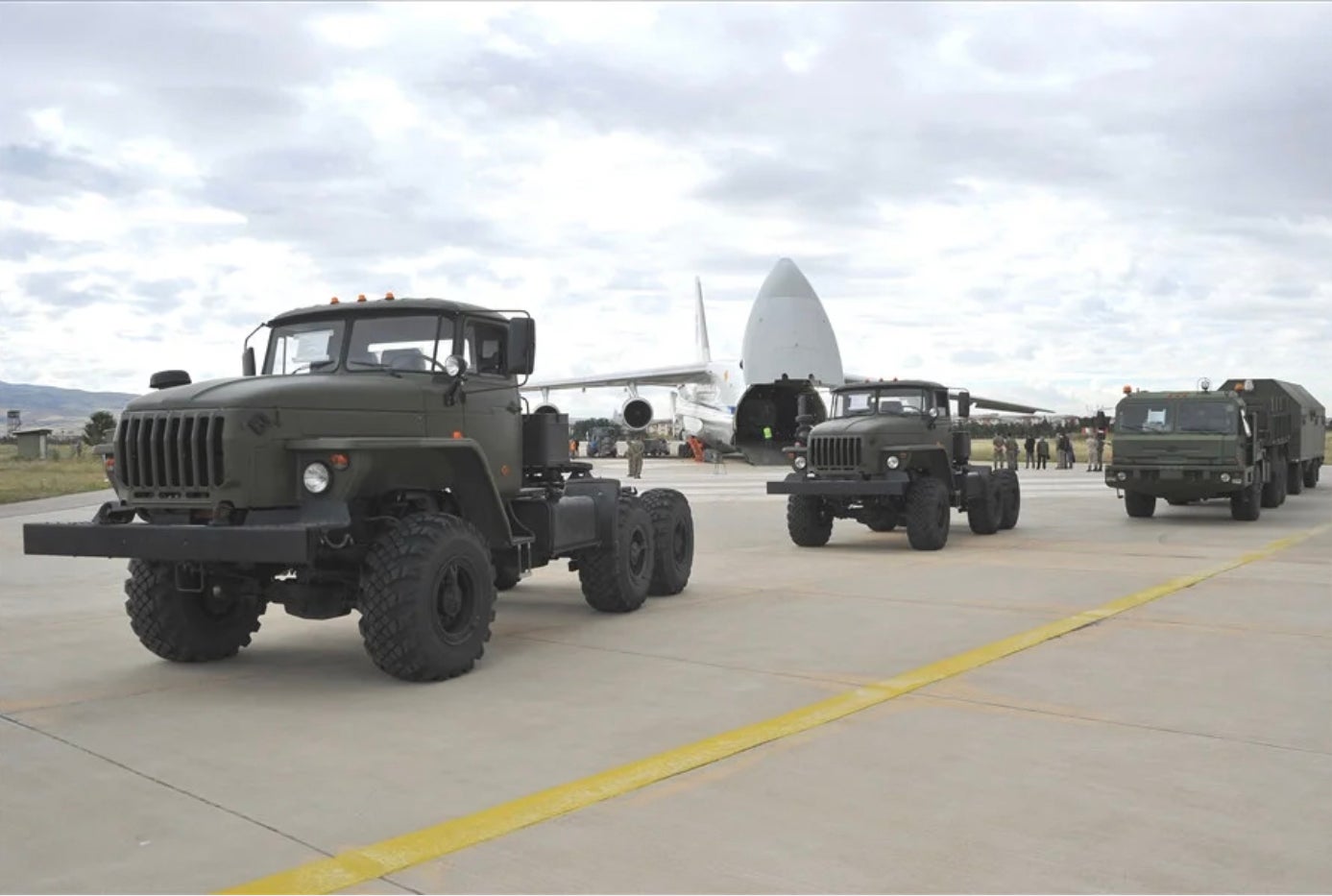
TURKISH MINISTRY OF NATIONAL DEFENSE
Components from the S-400 system are unloaded from an An-124 at Murted Air Base in Turkey, July 2019.
Haftar’s LNA — based in the eastern city of Tobruk — has received support from Russia, the United Arab Emirates, and Egypt, among others. The U.S. government also assesses that Russian mercenaries from the Wagner Group are operating in Libya on behalf of Haftar’s forces. Wagner has connections with Russia’s Main Directorate military intelligence agency, also known by the Russian acronym GRU.Too risky for Turkish airspace : Russian Air Force contractor 224th Flight Unit Antonov An124-100 Ruslan (NATO: Condor) RA82014 is flying from Ru AFB Mozdok to Al Khadim AFB in Al Marj #Libya pic.twitter.com/jFpnMqqcoW
— Yörük Işık (@YorukIsik) August 3, 2020
The LNA’s chief opponent is the U.N.-backed Government of National Accord (GNA), based in Tripoli, the country’s internationally recognized capital. Its primary international backer is presently Turkey.
While the photos of the purported SAM site reveal little in the way of detail, it’s been suggested they depict a truck-mounted 96L6 or 96L6E target acquisition radar, which NATO refers to as Cheese Board, together with a transporter-erector-launcher (TEL) associated with an S-300 or S-400-series SAM system. The S-400 seems a less likely proposition since it's probable that Moscow would be less willing to commit such an advanced system to the Libyan theater.
As others have noted, this does look like a LEMZ 96L6/E acquisition radar and a S-300 or S-400-series TEL (most likely an S-300 variant). The 96L6 can be used in conjunction with the S-400 or S-300PS/PMU, S-300PM/PMU1, and S-300PMU2 systems. 214/https://t.co/y6Qfl1fkNu
— Rob Lee (@RALee85) August 5, 2020
If the equipment at Ras Lanuf is as it seems, it marks another significant development in the conflict. Presuming the site is indeed an S-300 or S-400 battery, and if it was provided by Russia, it would demonstrate Moscow’s expanding efforts to enhance the LNA’s air power and air defenses, following the previous deployment of MiG-29 and Su-24 warplanes, as reported by The War Zone. Beginning in May, Russia supplied Libya with at least 14 combat jets and both sides in the conflict have been expanding their air and air defense capabilities.one of the pictures related to the 96l6/96l6e and possible s300 system seems to match the following area near ras lanuf
30.463892, 18.546362
h/t @_rikka99 https://t.co/1ZppOgY3wN pic.twitter.com/T6lMOjOpVH
— il kanguru (@il_kanguru) August 5, 2020
However, the precise capabilities of the alleged air defense system depend heavily on which sub-variant of S-300 or S-400 is involved, and the various missile subtypes, as well as to what degree the battery is integrated within a unified air defense network. The operational utility would also be determined by the level of situational awareness that’s available to their operators. The LNA’s Pantsir-S1 short-range air defense system — Russian-made, and supplied by the U.A.E. — has proven notably vulnerable to Turkish attack, especially by armed Bayraktar TB2 drones, although the precise reasons for this have been subjected to ongoing debate.
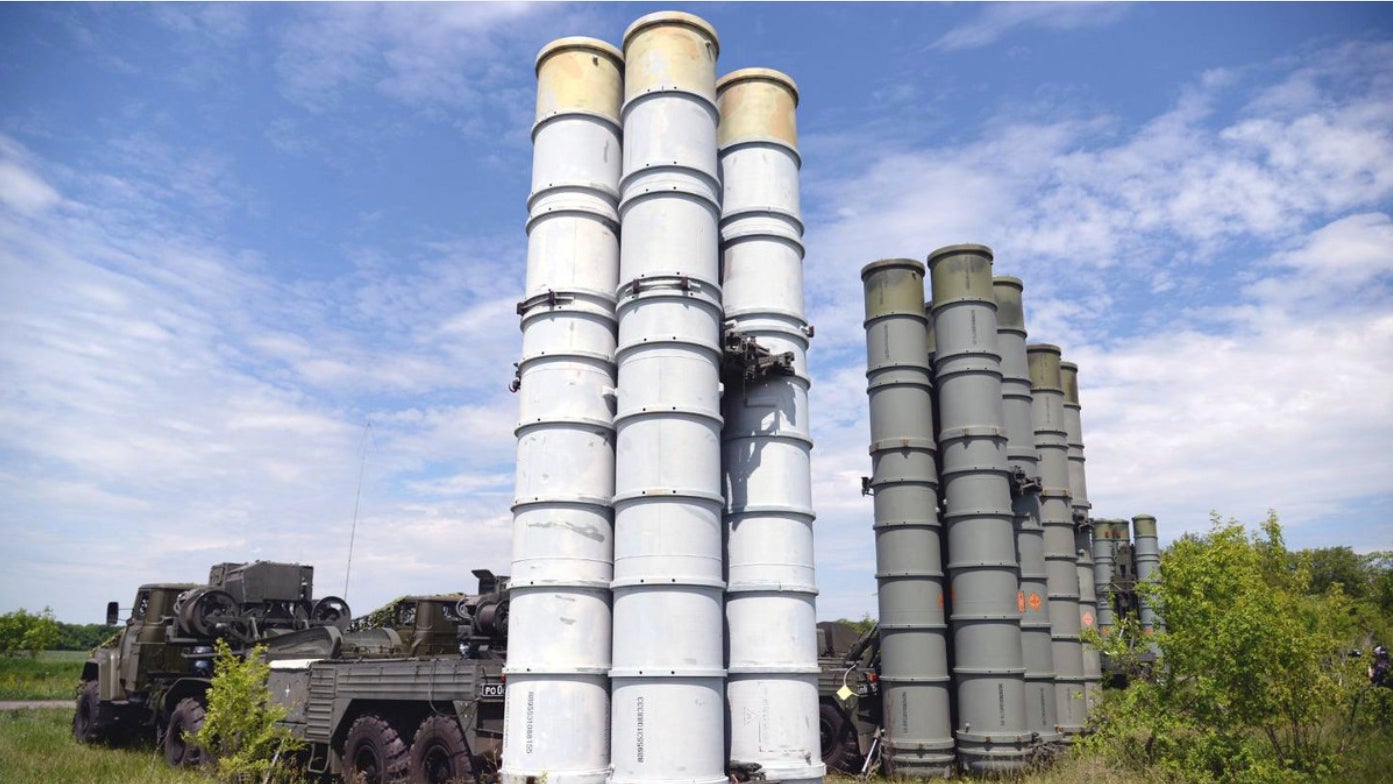
ULIANA SOLOVYOVA/SPUTNIK VIA AP
Transporter-erector-launchers associated with the S-300 in their deployed configuration.
While the S-300 — and even the more capable S-400 — might seem like overkill against the GNA’s limited aerial capabilities, even the TB2s, they could potentially serve as a deterrent to a wider Turkish intervention. A similar tactic was pursued by Russia in Syria, where an initial deployment of Russian-operated SAMs was followed by transfer of S-300s to the Assad regime. Those defenses, plus the introduction of Russian airpower, have played a fairly important role in maintaining Assad’s grip on power. In this previous feature, we examined how a similar approach might play out in Libya.
According to the assessment of U.S. Africa Command (AFRICOM), Russia is continuing to position military equipment in Libya capable of conducting “kinetic operations” in the country. “Russia continues to play an unhelpful role in Libya by delivering supplies and equipment to the Wagner Group,” said U.S. Marine Corps Maj. Gen. Bradford Gering, AFRICOM director of operations. “Imagery continues to unmask their consistent denials.”
The War Zone will continue to update this story as we wait for more substantial imagery to appear. In the meantime, it remains clear that Russia is continuing to establish a strategic foothold in Libya and that it’s also willing to commit increasingly capable systems to this conflict.
Contact the author: thomas@thedrive.com
posted for fair use

New Intel Indicates Russia May Have Sent S-300 Or S-400 Surface To Air Missiles To Libya
Initial photos from Ras Lanuf and recent transport flights suggest Moscow may have bolstered Haftar's defenses by providing advanced SAM batteries.
Posted for fair use.....
Iraq, Syria’s Turkmen communities a useful tool for Turkey
Sinem Cengiz
1 day ago

Before crash, AI Express pilot aborted two landings

Dubai-Kerala jet crash: Three students from Sharjah Indian School injured in…

 © Provided by Arab News
© Provided by Arab News
Short Url

 arab.news
Since the US-led anti-Daesh coalition’s operations in Iraq began, Turkey’s policy toward its immediate neighbor has been determined by four main aims: Avoiding the separation of Iraq along sectarian or ethnic lines; being on alert over the emergence of a potentially anti-Turkish government in the country; eliminating the threat posed by the Kurdistan Workers’ Party (PKK) along its border; and protecting the status of the Turkmen minority.
arab.news
Since the US-led anti-Daesh coalition’s operations in Iraq began, Turkey’s policy toward its immediate neighbor has been determined by four main aims: Avoiding the separation of Iraq along sectarian or ethnic lines; being on alert over the emergence of a potentially anti-Turkish government in the country; eliminating the threat posed by the Kurdistan Workers’ Party (PKK) along its border; and protecting the status of the Turkmen minority.
Ankara has recently given special attention to bolstering its ties with the Turkmen — a Turkic ethnic group native to Central Asia who live mainly in Turkmenistan, northern Iran and Afghanistan, as well as in Middle Eastern countries such as Lebanon, Iraq and Syria, where they reside along with large Arab and Kurdish populations. They have become one of the main pillars of Turkey’s Iraq policy. Ankara, which has long presented itself as the guardian of Turkmen minorities beyond its own frontiers, is trying to place its kin at the center of its influence on politics in Iraq.
Turkish Foreign Minister Mevlut Cavusoglu this week received Aydin Maruf, regional minister for ethnic groups of the Kurdistan Regional Government (KRG) in northern Iraq and also an executive board member of the Iraqi Turkmen Front. The agenda for their meeting included the recent developments in Iraq, bilateral relations with the KRG, and the Turkmen’s current situation. Cavusoglu reiterated Ankara’s support for the Turkmen via his Twitter account, posting: “Will always stand by our Turkmen brothers & sisters.” Maruf was appointed to the new KRG Cabinet at Ankara’s explicit request, as a sign of Prime Minister Masrour Barzani’s positive approach toward Turkey.
The Turkmen were among those that felt a large impact as a result of Daesh’s seizure of vast swaths of territory in northern and western Iraq in 2014. Many were forced to flee their homes and take refuge in other areas. The predominantly Turkmen areas of Tal Afar and Tuz Khurmatu topped the list of cities that saw the biggest number of Turkmen flee following Daesh’s emergence in Iraq. Though the Daesh presence has mostly been cleared, many Turkmen have not been allowed to return, leaving their community caught between Daesh terrorism and attempts to change Iraq’s demographic makeup.
In recent months, there have been reports that the PKK has started to gain control in Sulaymaniyah and in some parts of Kirkuk in northern Iraq, amid a recently launched military operation against the terrorists by the Turkish army. In June, the PKK even attacked and desecrated a Turkmen martyrs’ cemetery in Kirkuk, according to local reports. The media suggested that Turkmen flags were also removed in some parts of Kirkuk. This has raised eyebrows in Turkey, which fears the PKK is trying to engineer a demographic change in the Turkmen areas.
The same concern also relates to Syria. Turkish President Recep Tayyip Erdogan considers the Syrian Turkmen to be natural allies, not only due to their ethnic links but also because they share a common enemy: The Assad regime, which did not recognize them or other ethnic groups as minorities, preferring instead to stress the unity of the Arab nation. Even though the Turkmen didn’t experience the harsh oppression inflicted on other ethnic groups in the initial stages of the Syrian conflict, they joined the opposition ranks aiming to topple the regime. An armed Turkmen group — known as the Syrian Turkmen Brigades — although not very efficient, was established in the fight against the regime and was supported by Ankara.
Turkey is also concerned about the sectarian tension between Shiite and Sunni Turkmen, which are supported by different external actors. Maruf has previously stated that the Shiite Al-Hashd Al-Shaabi and the PKK were trying to “ignite the conflict” between Turkmen.
Despite Turkey’s support, the Turkmen have been unable to establish themselves as a strong political force. However, although they are relatively weak in power, their presence serves as a significant tool for Turkey to exert its influence in both Iraq and Syria.
Iraq, Syria’s Turkmen communities a useful tool for Turkey
Sinem Cengiz
1 day ago

Before crash, AI Express pilot aborted two landings

Dubai-Kerala jet crash: Three students from Sharjah Indian School injured in…

Short Url

Iraq, Syria’s Turkmen communities a useful tool for Turkey
Syrian Turkmen protest at Russian military intervention in their country, Istanbul, Turkey, February 7, 2016. (Getty Images) Since the US-led anti-Daesh coalition’s operations in Iraq began, Turkey’s policy toward its immediate neighbor has been determined by four main aims: Avoiding the...
 arab.news
arab.news
Ankara has recently given special attention to bolstering its ties with the Turkmen — a Turkic ethnic group native to Central Asia who live mainly in Turkmenistan, northern Iran and Afghanistan, as well as in Middle Eastern countries such as Lebanon, Iraq and Syria, where they reside along with large Arab and Kurdish populations. They have become one of the main pillars of Turkey’s Iraq policy. Ankara, which has long presented itself as the guardian of Turkmen minorities beyond its own frontiers, is trying to place its kin at the center of its influence on politics in Iraq.
Turkish Foreign Minister Mevlut Cavusoglu this week received Aydin Maruf, regional minister for ethnic groups of the Kurdistan Regional Government (KRG) in northern Iraq and also an executive board member of the Iraqi Turkmen Front. The agenda for their meeting included the recent developments in Iraq, bilateral relations with the KRG, and the Turkmen’s current situation. Cavusoglu reiterated Ankara’s support for the Turkmen via his Twitter account, posting: “Will always stand by our Turkmen brothers & sisters.” Maruf was appointed to the new KRG Cabinet at Ankara’s explicit request, as a sign of Prime Minister Masrour Barzani’s positive approach toward Turkey.
The Turkmen were among those that felt a large impact as a result of Daesh’s seizure of vast swaths of territory in northern and western Iraq in 2014. Many were forced to flee their homes and take refuge in other areas. The predominantly Turkmen areas of Tal Afar and Tuz Khurmatu topped the list of cities that saw the biggest number of Turkmen flee following Daesh’s emergence in Iraq. Though the Daesh presence has mostly been cleared, many Turkmen have not been allowed to return, leaving their community caught between Daesh terrorism and attempts to change Iraq’s demographic makeup.
In recent months, there have been reports that the PKK has started to gain control in Sulaymaniyah and in some parts of Kirkuk in northern Iraq, amid a recently launched military operation against the terrorists by the Turkish army. In June, the PKK even attacked and desecrated a Turkmen martyrs’ cemetery in Kirkuk, according to local reports. The media suggested that Turkmen flags were also removed in some parts of Kirkuk. This has raised eyebrows in Turkey, which fears the PKK is trying to engineer a demographic change in the Turkmen areas.
The same concern also relates to Syria. Turkish President Recep Tayyip Erdogan considers the Syrian Turkmen to be natural allies, not only due to their ethnic links but also because they share a common enemy: The Assad regime, which did not recognize them or other ethnic groups as minorities, preferring instead to stress the unity of the Arab nation. Even though the Turkmen didn’t experience the harsh oppression inflicted on other ethnic groups in the initial stages of the Syrian conflict, they joined the opposition ranks aiming to topple the regime. An armed Turkmen group — known as the Syrian Turkmen Brigades — although not very efficient, was established in the fight against the regime and was supported by Ankara.
Turkey is also concerned about the sectarian tension between Shiite and Sunni Turkmen, which are supported by different external actors. Maruf has previously stated that the Shiite Al-Hashd Al-Shaabi and the PKK were trying to “ignite the conflict” between Turkmen.
In chaos-torn countries such as Syria and Iraq, where actors of different levels exist, regional countries seek out local actors to preserve and extend their influence there. Ankara has, in recent years, begun to emphasize its historical and cultural links to countries or minorities throughout Europe, Central Asia, the Caucasus and the Middle East. One of the main ways it achieves this influence is by playing “big brother” to ethnic or religious groups that it perceives as its kin.Turkey fears the PKK is trying to engineer a demographic change in the Turkmen areas.
Sinem Cengiz
Despite Turkey’s support, the Turkmen have been unable to establish themselves as a strong political force. However, although they are relatively weak in power, their presence serves as a significant tool for Turkey to exert its influence in both Iraq and Syria.
- Sinem Cengiz is a Turkish political analyst who specializes in Turkey’s relations with the Middle East. Twitter: @SinemCngz
northern watch
TB Fanatic
northern watch
TB Fanatic
northern watch
TB Fanatic
northern watch
TB Fanatic
jward
passin' thru

Nic
@NicAthens
44m
This is the Ottoman dream of expansionist #Turkey, the Grey Wolves Turks wants the EEZ from #Tunisia to #Crete via GNA Libyan expired goverment, the EEZ from Crete to Cyprus through Turkish occupied #Cyprus and the half EEZ of #Greece in the Aegean.

Illegal Grey Wolves Turks don't recognize the International Law and EEZ on islands.

northern watch
TB Fanatic
It looks like there will be a battle soon, forces are massing
danielboon
TB Fanatic
This is going to go up at any time now
northern watch
TB Fanatic
northern watch
TB Fanatic
northern watch
TB Fanatic
northern watch
TB Fanatic
northern watch
TB Fanatic
northern watch
TB Fanatic
jward
passin' thru
(I said 24-48 hrs, and 24 have passed. . .for party to start in earnest)
intelfeedia
@intelfeedia
13m
#Russia deployed Panstir S1 surface-to-air missiles in #Sirte yesterday to reinforce the LNA as it prepares for a GNA-Turkish invasion. Missile system will counter #Turkey’s armed drones. #Egypt #Libya
@TheWarMonitor
@Mansourtalk
@Natsecjeff
@Almatrafi
View: https://twitter.com/intelfeedia/status/1292219536540758016?s=20
intelfeedia
@intelfeedia
13m
#Russia deployed Panstir S1 surface-to-air missiles in #Sirte yesterday to reinforce the LNA as it prepares for a GNA-Turkish invasion. Missile system will counter #Turkey’s armed drones. #Egypt #Libya
@TheWarMonitor
@Mansourtalk
@Natsecjeff
@Almatrafi
View: https://twitter.com/intelfeedia/status/1292219536540758016?s=20
Posted for fair use.....
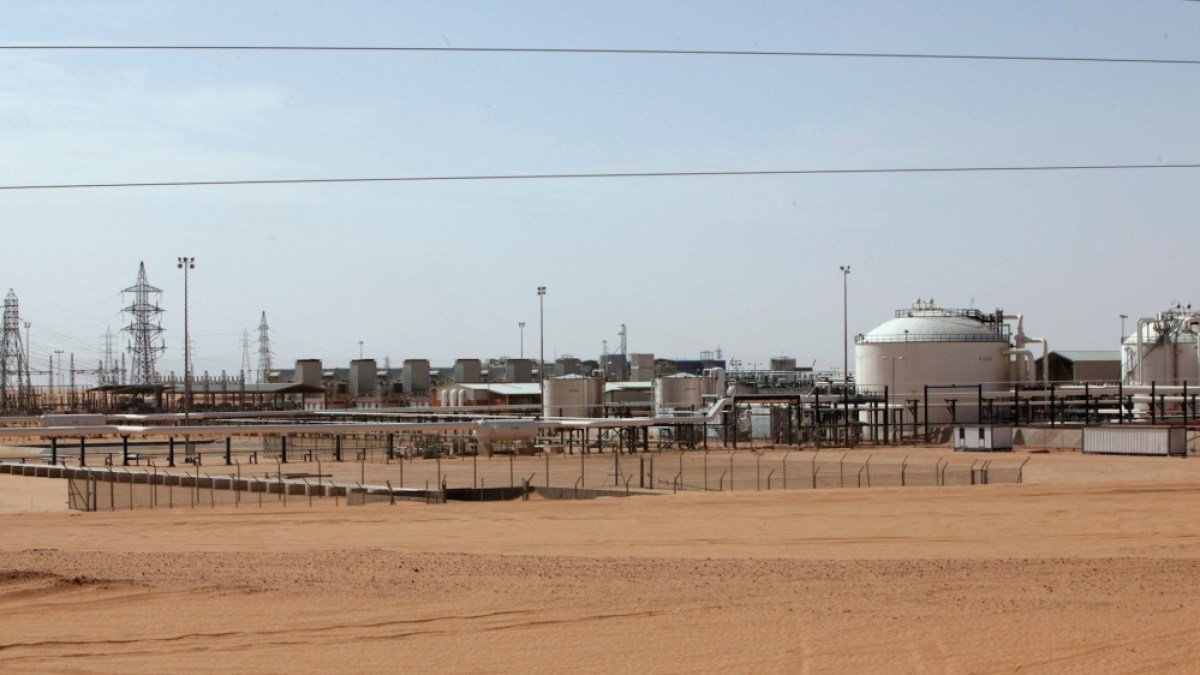
 www.aljazeera.com
www.aljazeera.com
Why Russian mercenaries seized control of key oilfield in Libya
Despite losing ground, Moscow sends war planes and Russian mercenaries to Libya. Plus, Lebanon's deadly explosion.
08 Aug 2020 06:37 GMT
Video
Russian mercenary groups have enabled renegade military commander Khalifa Hafter, who is based in eastern Libya, to blockade the country's oil exports, starving the country of much-needed money.
Moscow's backing of Haftar, a former CIA asset, has increased tensions with the United States. Russian private military contractors are active in 16 African nations. How is the country paying for its overseas wars?
Also on Counting the Cost: Currency crisis, debt default, hyperinflation and poverty - Lebanon was in economic and political paralysis long before the devastating explosion in Beirut. With corruption rife, is it time for a Marshall Fund?
Plus, we discuss weaponising data and disinformation to manipulate elections. Hostile nations are using artificial intelligence to get past social media defences.

Why Russian mercenaries seized control of key oilfield in Libya
Despite losing ground, Moscow sends war planes and Russian mercenaries to Libya. Plus, Lebanon’s deadly explosion.
Why Russian mercenaries seized control of key oilfield in Libya
Despite losing ground, Moscow sends war planes and Russian mercenaries to Libya. Plus, Lebanon's deadly explosion.
08 Aug 2020 06:37 GMT
Video
Russian mercenary groups have enabled renegade military commander Khalifa Hafter, who is based in eastern Libya, to blockade the country's oil exports, starving the country of much-needed money.
Moscow's backing of Haftar, a former CIA asset, has increased tensions with the United States. Russian private military contractors are active in 16 African nations. How is the country paying for its overseas wars?
Also on Counting the Cost: Currency crisis, debt default, hyperinflation and poverty - Lebanon was in economic and political paralysis long before the devastating explosion in Beirut. With corruption rife, is it time for a Marshall Fund?
Plus, we discuss weaponising data and disinformation to manipulate elections. Hostile nations are using artificial intelligence to get past social media defences.
northern watch
TB Fanatic
jward
passin' thru
EndGameWW3
@EndGameWW3
Update: Turkey has pulled around 20 ships out of UN/NATO obligations to form an Armada against Greece and Egypt. Some of these ships will be participating in the live fire drills in the Med on Monday and Tuesday.
GrantD
@Graetz77GD
4m
Egypt however is much more a match. As for naval and air forces, the Turkish & Greek forced are similarly sized but Turkey is more fanatical. Egypt though is likely to be a much bolder match for Turkey. Already, they have been facing off at each other through proxies.
@EndGameWW3
Update: Turkey has pulled around 20 ships out of UN/NATO obligations to form an Armada against Greece and Egypt. Some of these ships will be participating in the live fire drills in the Med on Monday and Tuesday.
GrantD
@Graetz77GD
4m
Egypt however is much more a match. As for naval and air forces, the Turkish & Greek forced are similarly sized but Turkey is more fanatical. Egypt though is likely to be a much bolder match for Turkey. Already, they have been facing off at each other through proxies.
northern watch
TB Fanatic
northern watch
TB Fanatic
northern watch
TB Fanatic
northern watch
TB Fanatic
northern watch
TB Fanatic
northern watch
TB Fanatic
northern watch
TB Fanatic
northern watch
TB Fanatic
northern watch
TB Fanatic
northern watch
TB Fanatic
northern watch
TB Fanatic
danielboon
TB Fanatic
What a nightmare in the Mediterranean
danielboon
TB Fanatic
5 min should be called pirates of the Mediterranean searching for oil


